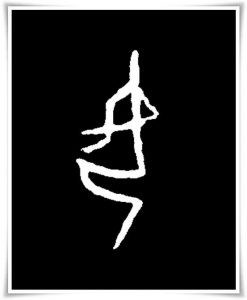
1. Meaning:
female, woman
2. Readings:
- Kunyomi (訓読み): おんな, め
- Onyomi (音読み): ジョ, ニョ, ニョウ
- Japanese names: おな, た, つき, な
- Chinese reading: nǔ, rǔ
3. Etymology
女 belongs to the 象形文字 (しょうけいもじ, shōkeimoji, i.e. set of characters of pictographic origin). It is a pictograph of a woman kneeling on the ground, shown with her arms entangled, holding a garment.
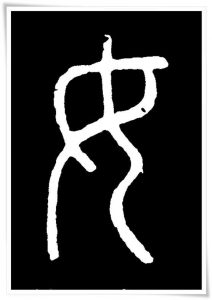
The definition of the character 女 found in “Explaining Simple (Characters) and Analyzing Compound Characters” (說文解字, pinyin: Shūowén Jiězì) from the 2nd century C.E., compiled by Xu Shen (許慎, Xǔ Shèn, ca. 58 C.E. – ca. 147 C.E.), a philologist of the Han dynasty (漢朝, pinyin: Hàn Cháo, 206 B.C. – 220 C.E.) is quite simple and straight forward. Xu states that the character 女 represents a woman.
There are many kinbun (金文, きんぶん, i.e. “text on metal”) inscriptions that refer to women and fertility. They indicate that rulers were commissioning the casting of bronze vessels upon which inscriptions of the wish for multiple children were recorded. For example, the inscription on the Qi Hou Yi (齊侯匜, pinyin: Qí Hóu Yí, lit. “Tea pot of the Duke of Qi”), a bronze vessel from the early Spring and Autumn period (春秋时期, pinyin: Chūnqiū shíqī, 771 B.C. – 476 B.C.), has a fragment which reads, in part, “eternal treasuring of the posterity” (子子孫孫永寶用, pinyin: zǐzǐ sūnsūn yǒng bǎoyòng).
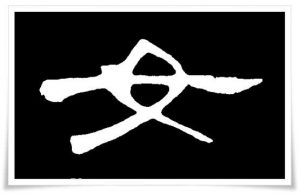
4. Selected historical forms of 女.
Figure 1. Oracle bone script (甲骨文, こうこつぶん, kōkotsubun) form of the character 女, Shang dynasty (商朝, pinyin: Shāng Cháo, 1600 B.C. – 1046 B.C.).
Figure 2. Ink rubbing of the small seal script (小篆, しょうてん, shōten) form of the character 女, found in the book “Explaining Simple (Characters) and Analyzing Compound Characters” (說文解字, pinyin: Shūowén Jiězì) from the 2nd century C.E., compiled by Xu Shen (許慎, Xǔ Shèn, ca. 58 C.E. – ca. 147 C.E.), a philologist of the Han dynasty (漢朝, pinyin: Hàn Cháo, 206 B.C. – 220 C.E.).

Figure 3. Ink rubbing of the mature clerical script (隷書, れいしょ, reisho) form of the character 女, found on the stele 曹全碑 (pinyin: Cáo quán bēi), Han dynasty (漢朝, pinyin: Hàn Cháo, 206 B.C. – 220 C.E.), 185 C.E.
Figure 4. Ink rubbing of the cursive script (草書, そうしょ, sōsho) form of the character 女 found in the calligraphy by Emperor Gaozong (高宗, pinyin: Gāo Zōng, 1107 – 1187 C.E.) of the Song Dynasty (宋朝, pinyin: Sòng Cháo, 960 – 1279 C.E.).
Figure 5. Highly graceful standard script (楷書, かいしょ, kaisho) form of the character 女, found on the Longcang Temple Stele (龍藏寺碑, pinyin: Lóngcángsì bēi), Sui dynasty period (隋朝, pinyin: Suí Cháo, 581 – 618 C.E.), 586 C.E.
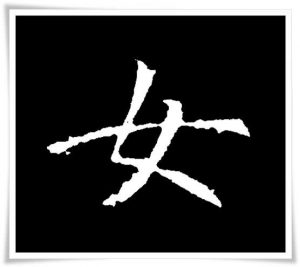
Figure 6. Semi-cursive script (行書, ぎょうしょ, gyōsho) form of the character 女 found in the famous Thousand Character Classic (千字文, pinyin: Qiānzìwén). This particular copy is attributed to the Sui dynasty calligrapher named Zhi Yong (智永, pinyin: Zhì Yǒng, exact birth and death dates are unknown).
5. Useful phrases
- 女子 (じょし, joshi) – a girl, woman
- 彼女 (かのじょ, kanojo) – she / her, girlfriend
- 男女 (だんじょ, danjo) – men and women
- 女性 (じょせい, josei) – female, woman
- 美女 (びじょ, bijo) – beautiful woman
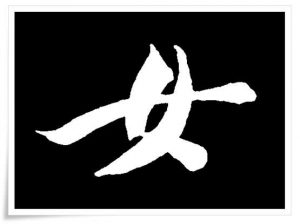
Text: Ponte Ryūrui (品天龍涙)
English editing: Rona Conti
Japanese/Chinese editing: Yuki Mori (Anada)
